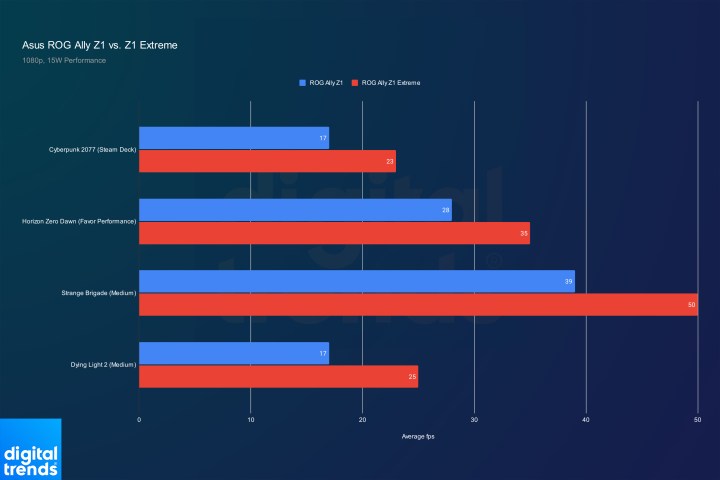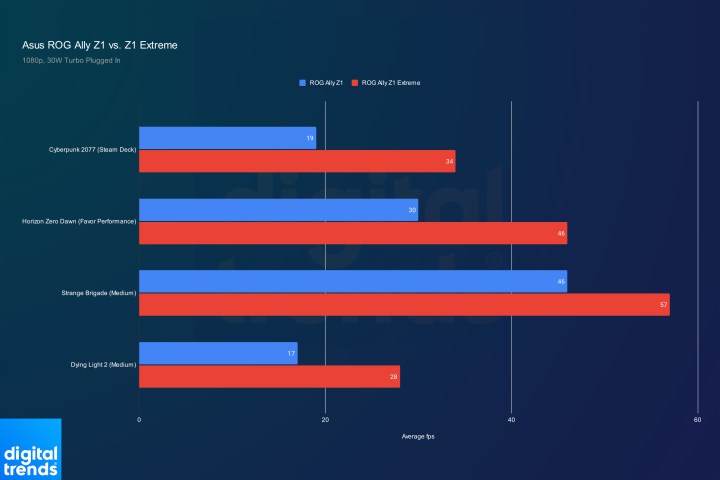Asus ROG Ally (Ryzen Z1)
MSRP $600.00
“The ROG Ally with the Z1 is weaker than even the Steam Deck, leaving it without a clear audience.”
Pros
- Light and comfortable to use
- Beautiful 1080p screen
Cons
- Weak battery life
- Worse performance than the Steam Deck
- Windows 11 is a hassle to use
When I reviewed Asus’s ROG Ally earlier this year, I was floored by its performance. The handheld debuted AMD’s Ryzen Z1 Extreme chip, which shot past the Steam Deck and established Asus’ handheld as the new performance king.
Now, we have the base Z1 model. It’s a stripped-down version of the chip we saw earlier this year, and it comes in cheaper than the Z1 Extreme model ($600 instead of $700). there’s less power, but the device still comes with the same 512GB of storage, same shared 16GB of LPDDR5 memory, and same beautiful 1080p, 120Hz screen. It’s just the processor that’s different.
And what a difference that makes. The ROG Ally Z1 isn’t a disaster, but it’s a device that doesn’t have any clear purpose. It’s a clear step below the Z1 Extreme, and it loses in a head-to-head battle with the Steam Deck. It’s a device that exists because it can, and I have a hard time believing it caters to any specific audience.
Let’s talk about the Ryzen Z1

You might assume that the Ryzen Z1 Extreme is a beefed-up version of the Ryzen Z1, but the line actually moves in the opposite direction. The Z1 Extreme sets the standard, and the Ryzen Z1 is big step backward.
For starters, the Ryzen Z1 only comes with six Zen 4 CPU cores, compared to the eight available on the Z1 Extreme. The more important cutback is in GPU cores, though. The Ryzen Z1 has four RDNA 3 GPU cores, which is only a third of what the Ryzen Z1 Extreme offers.
It’s a huge step back, and that comes out in the performance of the ROG Ally Z1. There’s also a slight cut to cache, from 8MB of L2 on the Z1 Extreme to 6MB of L2 on Z1. It’s not a huge deal, but I did need to allocate more of the shared 16GB of LPDDR5 memory to get games like Returnal to launch.
The Ryzen Z1 is powerful enough to run games, but it’s a significant step back from what the Z1 Extreme offers. It’s even a cut compared to the Steam Deck. Valve’s handheld has twice as many graphics Compute Units (CUs). They’re using an older architecture, but the higher core count means the Steam Deck edges out higher performance, as my testing shows.
By the numbers

The Steam Deck comparison is the best place to start because it sets the stage for the power you can expect out of the ROG Ally Z1. As you can see from my testing, Asus’ new handheld is behind the Steam Deck in every game I looked at. There are some minor differences, such as in Horizon Zero Dawn, but in games like Dying Light 2, the performance gap is the difference between playable and unplayable.
In fairness to the new ROG All Z1, it’s technically cheaper than the Steam Deck. It comes with 512GB of storage, and you’ll need to spend $650 for a Steam Deck with the same amount. However, you can pick up a Steam Deck for as little as $400 with 64GB of storage and expand it with a micro SD card — at least there aren’t concerns about bricking your Micro SD card like there is on the ROG Ally.
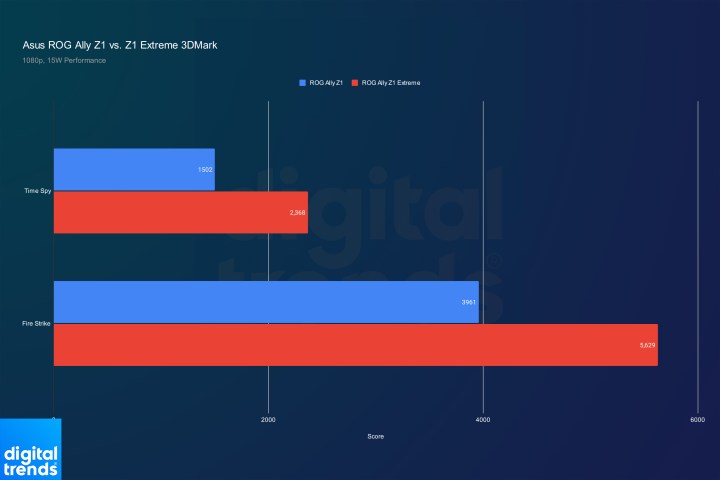
You can see the comparison with the Z1 Extreme model above. Digging down, at the default 15-watt Performance mode, the ROG Ally Z1 is about 37% slower than the Z1 Extreme model in 3DMark Time Spy, and a clean 30% slower in Fire Strike.
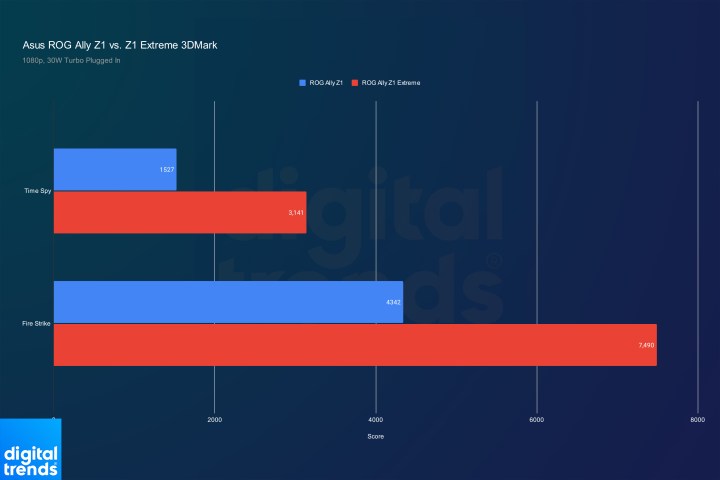
That’s not the worst of it, though. With the Turbo mode and both devices plugged in, offering 30 watts of power, the Z1 Extreme clobbers the base Z1 model. The ROG Ally Z1 ends up 51% slower in Time Spy and 42% slower in Fire Strike.
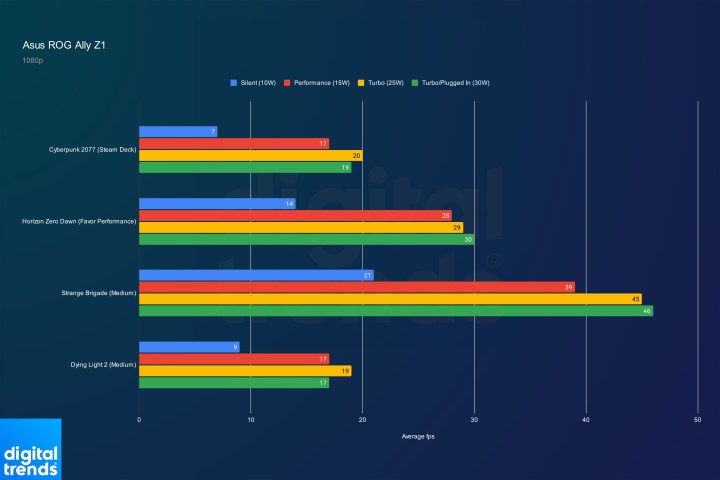
That’s a huge gap between the Performance and Turbo modes, and that’s something I saw across my tests. You can see a breakdown of performance across the various modes in the ROG Ally Z1 above. There are some games, such as Strange Brigade, where extra wattage helps. But in most cases, the difference is only a few frames, all while draining your battery much faster.
That’s not the scaling we see with the Ryzen Z1 Extreme model of the ROG Ally. In the Performance mode, you can see the Ryzen Z1 is about 20% behind the Ryzen Z1 Extreme model. Jump up to the Turbo mode, however, and the Ryzen Z1 model is 35% slower.
Throughout my testing, it’s clear that the Ryzen Z1 version of the ROG Ally just can’t take advantage of the additional power. It’s hitting a hard wall, likely due to its low core count, and you don’t have options to improve performance like you do on the ROG Ally with the Z1 Extreme.
The subjective experience

The numbers are important for comparison, but the reality of devices like the ROG Ally and Ayaneo 2S is that you’ll need to fiddle with settings and upscaling to get playable performance. How does that experience hold up on the ROG Ally with the Ryzen Z1? It’s not great.
Let’s start with the main issue: battery life. I didn’t experience any major differences in battery life on the ROG Ally Z1 compared to the model with the Z1 Extreme. That means you can squeeze about four hours of life in low-lift indie games, two hours in a big AAA game with a cap at 30 frames per second (fps), and about an hour if you shoot up to Turbo mode and let the frames run wild.
The issue with battery life became particularly apparent when I was playing Sea of Stars. This 2D indie RPG can run for hours on a device like a Steam Deck without issues, but the ROG Ally with the Z1 was half dead after 90 minutes of playing. Some of that could be due to Windows 11 running in the background on the ROG Ally, but it mainly comes down to the screen.
Just like the Z1 Extreme model, this version of the ROG Ally comes with a bright 1080p screen with a 120Hz refresh rate. It’s just as beautiful as before too, highlighting the gorgeous pixel art in Sea of Stars. It’s just a massive drain on the battery, even in a game that isn’t demanding like Sea of Stars.
It’s true that Asus provides options to conserve battery life: turn down the refresh rate or run the display at a lower resolution. That defeats the purpose of having the ROG Ally for games like Sea of Stars, though. If I need to turn down the resolution and refresh rate to get acceptable battery life, I’m just going to play the game on my Steam Deck. At least there I get access to things like the Steam overlay and the ability to put the device into rest mode.
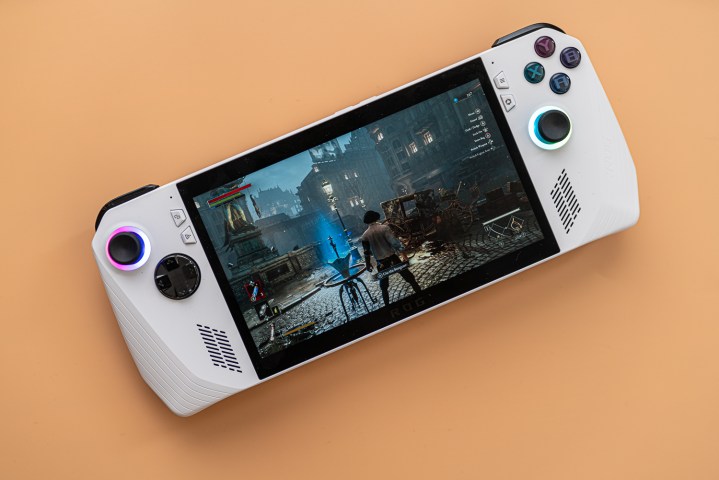
What about something more demanding, though? I played through a few hours of both Red Dead Redemption 2 and Lies of P. In Red Dead Redemption 2, I was finally able to get a stable 30 fps with Low settings, but I had to butcher the image with the built-in Radeon Super Resolution (RSR) to get there. It was playable, but the constant flickering from the upscaling was distracting.
Similarly, in Lies of P, I was only able to hit 60 fps with the game’s Ultra Performance mode of FidelityFX Super Resolution (FSR) and the Turbo mode on. Within 30 minutes, I had already drained half of the battery, and that was with the screen brightness turned down.
I also attempted Starfield, but given the messy 720p image quality combined with performance around the 15 fps mark, I couldn’t stomach playing for long.
It’s hard to justify the ROG Ally with the Ryzen Z1. With the Z1 Extreme model, you have to deal with getting around Windows 11 and low battery life compared to the Steam Deck, but you’re getting a much more capable device in terms of performance. With the base Ryzen Z1, the ROG Ally becomes slightly slower than the Steam Deck, with all the same quirks that hold the ROG Ally back.
Difficult to recommend
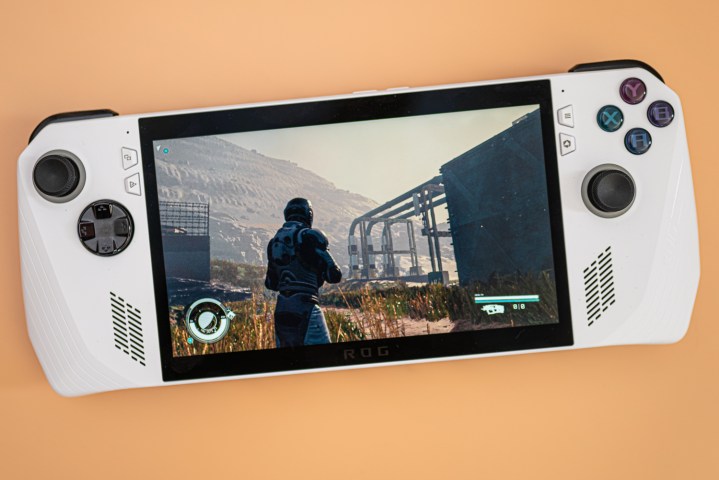
I have a hard time recommending the ROG Ally Z1 to anyone. It doesn’t fit any role that isn’t already filled by the Steam Deck or the ROG Ally with the Z1 Extreme. If anything, the $600 list price seems like a way to push you toward the more expensive $700 model. It’s more than worth that upcharge.
With the Steam Deck and ROG Ally Z1 Extreme, there are trade-offs. The Steam Deck isn’t as powerful, but it’s much more stable, on top of being easier to use and coming in at a lower price. For my personal use, that was enough for me to stick with the Steam Deck. The ROG Ally Z1 Extreme is more expensive and cumbersome, but it can also play any game that runs on Windows, and with a higher peak level of performance. It even comes with some bonuses like the ability to hook up the Asus ROG XG Mobile for desktop gaming.
Unfortunately, there’s nothing tipping the scales in favor of the ROG Ally Z1. It makes the same concessions as the model with the Z1 Extreme without any of the upsides.
Editors’ Recommendations


